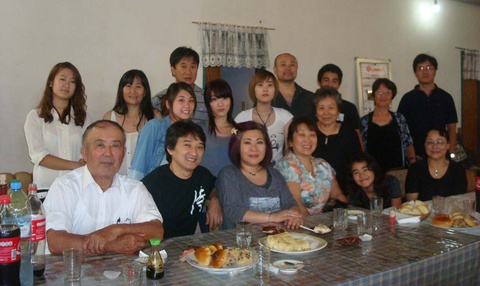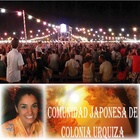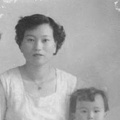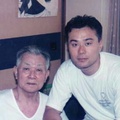Read part XI (Part 1) >>
Mr. Tsuru in Argentina
Tsurusan helped the community in countless activities; For example, being part of the commission of the Japanese La Plata Association, he helped found the language school, where it currently operates. He held several positions, of the La Plata Japanese Association he was president, secretary four times and was a member of the electricity commission as secretary. He was also president of Fukuoka Kenjinkai for several years (1994-1999). He participated in Sekai Taika Brasil (1995), Sekai Taika Hawaii (1998, accompanied by his wife) and Sekai Taika Tokyo (1998). He was four times president of Kyoren, 4 times secretary (1982-1984) and 2 vice presidents, in 1999 and from 2011 to October 2014.
Being a member of the AJA commission as a member, Tsurusan helped in the recovery of the Japanese Garden with a property donated by the Argentine Government to the Japanese Community (land of Recoleta in 1964). Before completing the work, this garden was visited by the princes of Japan, but only in 1978 did its final restructuring begin thanks to the Pro Japanese Garden commission; Mr. Tsuru's name appears on a plaque for his participation. The princes and the emperor visited the Japanese Garden again, in 1999 Akihito and in 2014 Akihito and his wife. Tsuru san was also auditor of NIPPAR in 1985. In 1989 he was president of Nihongo Gakko La Plata, when the schools were not yet unified. In 1992 he was Vice President of Nihongo Gakko La Plata with the unified schools to maintain and reinforce the language and was part of a commission to help the school in different events.
From 2004 to 2010, he was in Japan working in the city of Kanagawa, hired by an employment agency that got him a security position and then a grocery clerk position. She returned to Argentina to meet her granddaughter, to attend her son's wedding and then her youngest daughter's wedding, staying in Argentina to process her retirement. The community suggested that he teach Kendo classes at the La Plata Japanese Association, where one of his students was his own oldest grandson. Many have commented that both he and his daughter were very good exponents of this discipline.
The family tree
Mr. Tsuru married NT (both flower growers) and they had 3 children. They arrived in Argentina as part of the 1958 migration wave, entering Paraguay first and in 1964 they moved to Argentina. Tsuru san's parents were: Jiro (1912-1998), an agronomist by profession, married around 1936 to Chiyo Hiroki (1916-2009). Jiro's parents were: Keizo Kuroda (1885) 1 and Matsuno (1903). There was a last name change from Keizo Kuroda 2 to Tsuru. This modality was accepted so as not to lose a surname and maintain it. This was recorded in the koseki and this practice is known as “yoshi” because the wife's surname is adopted 3 .
Matsuno's parents were: Kakutaro father and Chie, mother. Chiyo's parents were: Seichi (father - 1885) and Wari (mother - 1888). Chiyo had 6 brothers: Takeshi, “Colonel” 4 (son: Takashi), Yuri (had 8 sons), Kiri (had 3 daughters), Sumi (1 son), Toru (had Jirki, who had 2 sons) and Kyo (2 children).
Jiro had 9 siblings (7 boys and 3 girls), Ichiro (had 4 daughters and 1 son), Takaishi (+ 2011, had 2 sons), Machiko (2 sons), Miyuki (no sons, + Second War in New Guinea) , Kenoitsuke (+1957), Kiono (had one son), Reyko (+1987), Keishi (had 2 children), Tamiko (+1992, one son).
Jiro's children currently live in Argentina, most of them in Colonia Urquiza 5 :
- Michiko (1938) married Tamotsu Takahashi (1936, +1988) in 1960 and they had Hi (1963, married to NK and they have a daughter) and Gu (1969).
- Osamu (1940, + 2014) migrated from Paraguay to Argentina with his wife Fumie (1939), called by the sister who lived in Chivilcoy. Then Takeo, Tsurusan and the parents arrived. Later everyone moved to Colonia Urquiza. Tsurusan was assigned to transport everything in 10 trucks.
Osamu and Fumie had 2 children: Ana (1967) married in 1988 to Y, and live in Florencio Varela with their two children (1992 and 1989) and A (1962), married in 1989 to T. T, who live in La Plata and they had 3 children (1990,1993 and 1995).
- Mr. Tsuru (1942) married in 1968 to NT (1947), they had 3 children: Antonio (1970), lives in Argentina, with his wife Irene Isabel Cafiero (1969); Married in 1998, they have two children: KF (2000) and SI (2004),
- RK (1974) lives in Japan.
- SA (1980) currently lives in Peru, married in 2010 to TO (1980).
- Takeo (1945) currently lives in Concordia, married to SN; They had two daughters (1970 and 1974), both doctors, one lives in Japan and the other in Corrientes.
Rescuing the experiences of immigrants means continuing to build stories. This biography is just one of many that took root outside of Japan 6 .
Grades:
1. The version that the surname Kuroda comes from intellectuals is known, and it is believed that it is linked to the story of Viscount Seiki Kuroda (August 9, 1866 - July 15, 1924), pseudonym of a Japanese painter and professor, known for wearing the Western theories about art to the vast Japanese public. He was one of the leaders of Western-style yoga. His real name was Kiyoteru Kuroda.
2. Another case of changing the surname of a Kuroda family (possible family branch) is that of Princess Sayako, known as Nori, who renounced her dynastic titles and left the imperial family upon her marriage in 2005. with Yoshiki Kuroda, an urban designer from whom he took his new civil surname.
3. Keizo was the first teacher according to the new teacher regulations and at the age of 32 he was elected director of the school, who later referred him to other educational establishments in the area. He studied at Shinan Gakko. When he was at Yanagawa school, he met the great poet Kitahara Hakushu, who came from a sake-making family that collapsed due to the crisis and escaped to Tokyo. This poet wrote for both adults and children, there are many songs from the Second War period that have his lyrics and that are still sung today.
Keizo and two friends wanted to honor the poet and invited him to Yanagawa on several occasions. A large collection was made among neighbors to raise money and buy the poet's house to make it a museum. Tsuru san says that his sister Mchko donated three photos from the family album to the museum, where the poet can be seen walking with grandfather Keizo who at that time was director of the school, walking through the halls of the establishment.
4. The story of the Captain (who was in Tokyo, in Saitama) is very interesting, he went from high school to having a military degree without having completed a military career. He was demoted in honor for having been discovered by North American troops as a spy in the Second World War (very recently he had been assigned to the place he called data, head of spies, a Russian was the one who discovered them and notified American troops). He was awarded the position and saved all his subordinates (the prime minister and those who followed him had to resign, so the captain resigned from his position and stayed to live in Saitama, where he had children and died in 2004. , but in his later years he said he wanted to be mayor of Yanagawa). In the Tsuru family, Mr. Tsuru's sons: AH and RK pursued administrative police careers. One son dedicated himself to a branch of medicine (Dental Technician) and the other continued a career in law. Daughter SA, after graduating as a school teacher with a specialization in Japanese, also pursued a career in law.
5. Colonia General Justo José de Urquiza (commonly called Colonia Urquiza) is located near the town of Melchor Romero. At the time of the arrival of the first immigrants it was called Municipalidad María Eva de Perón. The first immigrants to settle in the place were the Italians, in 1957, then the Japanese arrived in 1961. Currently there are several immigrant communities that coexist harmoniously, making it a living example of interculturality.
6. With the authorization of the descendants, the privacy of the family has been respected and with this the publication was possible. Only the first name is kept for those who have died and the initials of those who are alive are respected.
© 2015 Irene Isabel Cafiero







